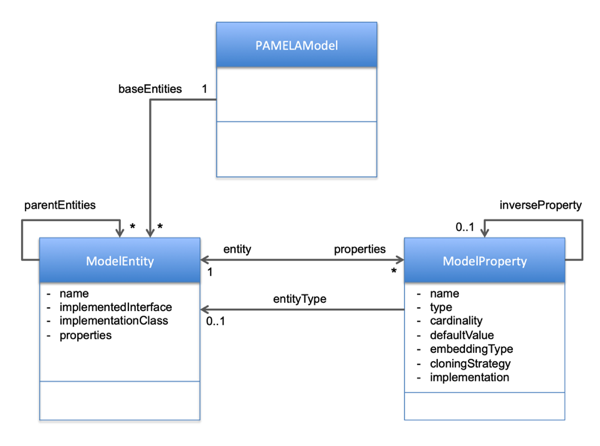Meta-programming support
Following figure represents PAMELA metamodel.

Concept of ModelProperty represent access to a value (simple or with multiple cardinality). This read-access is implicitely implemented using get: protocol. Following the same logic, PAMELA properties may expose following protocols used to define semantics of the ModelProperty :
get:read-access to a data. This protocol is implemented by all kind of ModelProperties.set:write-access to a data. This protocol is implemented by ModelProperties implementingSettablePropertyImplementationAPI.add:andadd:AtIndex:add-access to a multiple cardinality data. These protocols are implemented by ModelProperties implementingMultiplePropertyImplementationAPI.reindex:To:reindex a value to a given index in a multiple cardinality data. This protocol is implemented by ModelProperties implementingMultiplePropertyImplementationAPI.remove:remove-access to a multiple cardinality data. This protocol is implemented by ModelProperties implementingMultiplePropertyImplementationAPI.delete:andundelete:delete/undelete protocols, implemented by all ModelProperties
Unless specified in @PropertyImplementation PAMELA annotations, default implementation is provided for the PAMELA interpreter. This default implementation, also called the ModelProperty standard semantics, is encoded in well identified classes which are extendable to provide specific ModelProperty semantics.
PAMELA allows programmers to define their custom implementation for a given set of properties, while providing a class implementing @PropertyImplementation API and some protocol implementation (depending on the nature of the ModelProperty. Following excerpt of code illustrate use of two custom property implementations, with specific semantics.
@ModelEntity
public interface MyConcept {
static final String VALUE = "value";
static final String SUB_CONCEPTS = "someSubConcepts";
@Getter(value = VALUE)
@PropertyImplementation(MyPropertyImplementation.class)
String getValue();
@Setter(VALUE)
public void setValue(String value);
@Getter(value = SUB_CONCEPTS, cardinality = Cardinality.LIST)
@PropertyImplementation(MyListCardinalityPropertyImplementation.class)
@Embedded
List<MySubConcept> getSubConcepts();
@Adder(SUB_CONCEPTS)
void addToSubConcepts(MySubConcept subConcept);
@Remover(SUB_CONCEPTS)
void removeFromSubConcepts(MySubConcept subConcept);
}
public class MyPropertyImplementation extends DefaultSinglePropertyImplementation<Concept, String> {
public MyPropertyImplementation(ProxyMethodHandler<Concept> handler, ModelProperty<Concept> property)
throws InvalidDataException {
super(handler, property);
}
// Implements get: protocol
// ('concatenate' semantics)
@Override
public void set(String aValue) throws ModelDefinitionException {
String oldValue = get();
if (get() != null) {
super.set(aValue + get());
}
else {
super.set(aValue);
}
}
}
public class MyListCardinalityPropertyImplementation<I, T> extends AbstractPropertyImplementation<I, List<T>>
implements MultiplePropertyImplementation<I, T> {
...
// Implements get: protocol
public List<T> get() {
...
}
// Implements add: protocol
public void addTo(T aValue) throws ModelDefinitionException {
...
}
// Implements remove: protocol
public void removeFrom(T aValue) {
...
}
}
Such mechanisms are really usefull to control and fine-tune code implementation. Suppose for example that you have a code used in monothreading context: all your multiple cardinality properties will rely for example on a ArrayList implementation. Instead of replacing all occurences of ArrayList by Vector (multi-thread safe version of Java List) in generated code, the developer has just one modication to do, in adequate PropertyImplementation.